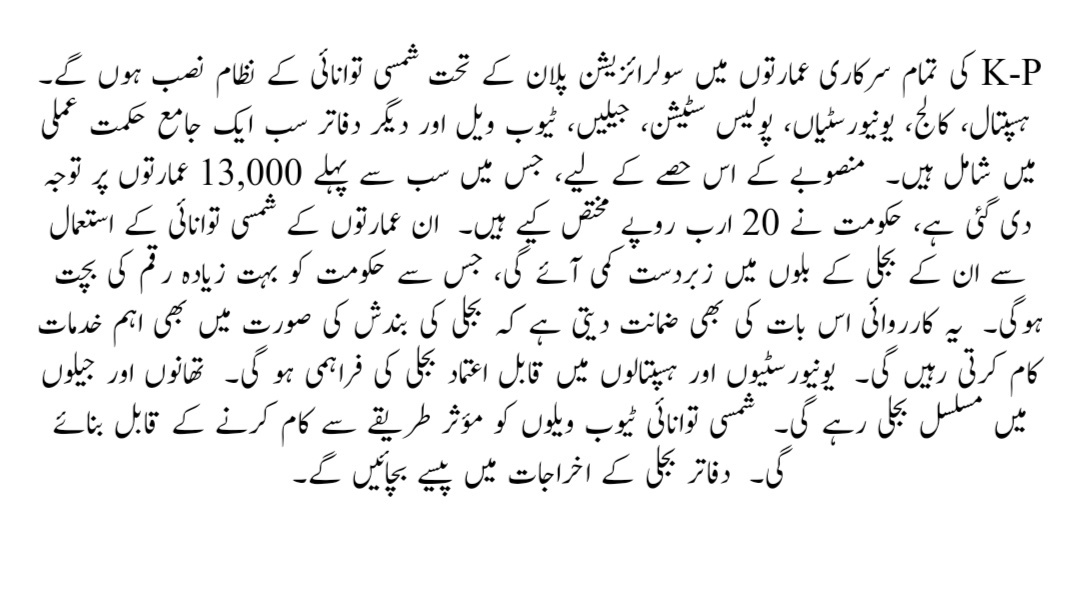In order to alleviate the province’s persistent electricity shortage, the Khyber Pakhtunkhwa (K-P) administration has started a significant solarisation project. Under the direction of Chief Minister Ali Amin Khan Gandapur, this project intends to supply impoverished households and government buildings with sustainable energy solutions. The effort, which is expected to cost 55 billion rupees, aims to lessen K-P residents’ reliance on conventional energy sources and cut their electricity costs. The government wants to build a more dependable and environmentally responsible energy infrastructure by switching to solar electricity.
Key Details of the Solarisation Project
| Key Information | Details |
| Project Name | Solarisation Project |
| Total Investment | 55 billion rupees |
| Beneficiaries | 130,000 households and government buildings |
| Implementation Partners | Bank of Khyber and KP Energy Development Organisation (KPEDO) |
Solar Power for Government Buildings
All K-P government buildings will have solar power systems installed as part of the solarisation plan. Hospitals, colleges, universities, police stations, jails, tube wells, and other offices are all included in an all-inclusive strategy. For this portion of the project, which first focusses on 13,000 buildings, the government has allotted 20 billion rupees. These buildings’ use of solar energy will drastically lower their electricity bills, which will save the government a lot of money. This action also guarantees that critical services continue to function even in the event of a power outage. Universities and hospitals will have dependable electricity supplies. There will be continuous power to police stations and prisons. Solar energy will enable tube wells to function effectively. Offices will save money on electricity costs.

Solar Systems for Low-Income Households
The project intends to equip 130,000 low-income families in K-P with solar systems in addition to government buildings. This initiative will cost about 35 billion rupees in total. The remaining 65,000 families will receive solar systems at a 50% discount, while 65,000 families will receive them for free. The goal of this assistance is to lessen the high electricity costs that many low-income families must pay. The government makes sure that people who need it the most get it by giving priority to areas that have frequent power outages. Free solar systems are given to 65,000 families. 65,000 families receive a 50% discount on solar systems. Pay attention to places where load shedding occurs frequently. Electricity costs for low-income households have significantly decreased.
Partnership and Implementation
The Bank of Khyber and the Khyber Pakhtunkhwa Energy Development Organisation (KPEDO) have signed two memorandums of understanding (MOUs) to guarantee the solarisation project’s successful completion. Chief Minister Gandapur was the honoured guest at the signing event on November 9, 2024. In order for the government to effectively distribute and install solar systems throughout the province, these collaborations are essential for obtaining the required funds and resources. Working together with energy and financial institutions facilitates the implementation process and guarantees the project’s timely and successful completion. MOUs were made with KPEDO and Bank of Khyber. The signing ceremony was attended by Chief Minister Gandapur. ensures that the project is implemented smoothly. Sufficient funds and resources were obtained for the project.
Benefits of the Solarisation Project
The residents of K-P stand to gain a great deal from the solarisation initiative. The government wants to lower the high electricity costs that many homes face by implementing solar energy. By lowering the overall demand for electricity, the project will also lessen the strain on the national system. An eco-friendly and sustainable energy source, solar power helps the province achieve its “Green Budget” objectives. This program encourages the use of renewable energy, which is essential for long-term sustainability, in addition to financial savings. reduced household electricity costs. less strain on the country’s grid. encouragement of renewable energy sources. backing for the Green Budget’s programs.
Future Prospects and Sustainability
An innovative project that paves the way for a more sustainable and energy-efficient future is the K-P government’s solarisation project. The province is making a big move towards adopting green energy solutions and lowering its carbon footprint by investing in solar electricity. The effective execution of this project can demonstrate the advantages of using renewable energy and serve as an example for other Pakistani regions. Additionally, the project’s emphasis on low-income houses and government buildings guarantees a broad impact, enhancing many locals’ quality of life and promoting a sustainable culture. establishes a standard for Pakistan’s renewable energy. lowers the carbon footprint of the province. improves inhabitants’ quality of life. encourages a sustainable culture.
Also Read More:Punjab Provides Free Tractors and Land Levellers to Support Wheat Farmers
Conclusion
An important step in resolving the province’s electricity crisis is the K-P government’s solarisation project. The initiative’s goal is to make electricity more sustainable and inexpensive by supplying solar power to low-income households and government buildings. The project’s effective execution is guaranteed by the partnership with energy and financial institutions, and the emphasis on renewable energy promotes long-term environmental objectives. The residents of K-P gain from this all-encompassing strategy in a number of ways, including lower electricity bills and increased use of clean energy.
FAQs
1. How much will the solarisation project cost in total?
The project will cost 55 billion rupees in total.
2. How many families will the solar systems benefit?
130,000 solar systems will be distributed to low-income homes.
3. How do homeowners receive their solar systems?
An additional 65,000 families will receive solar systems at a 50% discount, while 65,000 families will receive them for free.
4. Which government structures will be outfitted with solar energy systems?
Solar power systems will be installed in hospitals, colleges, universities, police stations, jails, tube wells, and other workplaces.
5. Who are the project’s implementation partners?
The Khyber Pakhtunkhwa Energy Development Organisation (KPEDO) and the Bank of Khyber are collaborating to carry out the project.
6. What advantages does the solarisation project offer?
The initiative will help the province’s Green Budget objectives, encourage renewable energy, lessen the strain on the national system, and minimise electricity rates.
